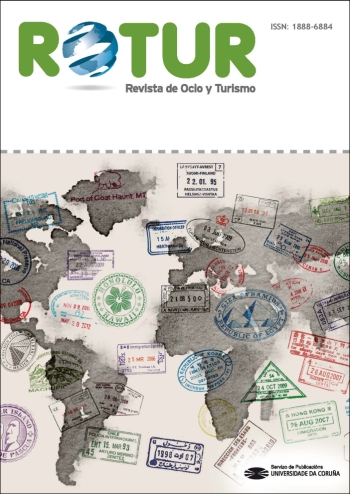The influence of gastronomy on tourism development in O Grove (Galicia)
Main Article Content
Abstract
The aim of this article is to examine the influence of gastronomy on tourism development in the town of O Grove, a key holiday destination in the Galician Rías Baixas, in order to assess the importance of the restaurant sector in O Grove and its effect on tourist numbers and hotel services in the area. The study explores the significant capillarity of the culinary tourism sector and how this has benefited the local rural economy. The analysis also examines the different types of restaurant services available, ranging from high-end to low-cost, and how these meet the demands of the diverse tourist population. The study concludes by highlighting the existing benefits and future potential of culinary tourism in O Grove.
Keywords:
Downloads
Metrics
Article Details
References
Aprile, María Carmela, Caputo, Vinzencina y Nayga, Rodolfo (2016). Consumers preferences and attitudes toward local food products. Journal of Food Products Marketing, 22(1), 19–42. https://doi.org/10.1080/10454446.2014.949990
Athena, H.N., Lumbers, Mark y Eves, Anita (2012). Globalisation and Food consumption in tourism. Annals of Tourism Research (39)1, 171-196. https://doi.org/10.1016/j.annals.2011.05.010
Batat, Wided (202O). El papel de la gastronomía de lujo en el turismo culinario: un estudio etnográfico de los restaurantes con estrella Michelín En Francia. Revista Internacional de Investigación Turística 23(2), 150-163. https://onlinelibrary.wiley.com/doi/10.1002/jtr.2372
Cohen, Erik y Avieli, Nir (2004). Food in tourism: attraction and impediment. Annals of Tourism Research 31(4), 755-778. https://doi.org/10.1016/j.annals.2004.02.003
Costa, Bea (16 de noviembre de 2020). El centollo que no se come en los restaurantes llena las mesas de casa. La Voz de Galicia. https://www.lavozdegalicia.es/noticia/arousa/o-grove/2020/11/15/centollo-come-restaurante-llena-mesas-casa/0003_202011A15C1991.htm
Di Clemente, Elide, Mogollón, José Manuel y Guzmán-López, Tomás (2014). La gastronomía como patrimonio cultural y motor del desarrollo turístico. Un análisis DAFO para Extremadura. Tejuelo: Didáctica de la Lengua y la Literatura. Educación, (9), 817-833.
Dixit, Saurabh Kumar (Ed). (2019). El manual de turismo gastronómico de Routledge. London, United Kingdom. Routledge.
Dencker, A.F.M. (1998). Métodos e técnicas de pesquisa em turismo. São Paulo, Brasil. Futura.
Dinamiza Asesores (2017). II Estudio de la Demanda Turística. https://dinamizaasesores.es/turismo/turismo-gastronomico/ii-estudio-la-demanda-turismo-gastronomico-espana/
Hjalager, Anne Matte y Richards, Greg (Eds) (2002). Demand for the gastronomy torusim product. Motivational factors. In: Tourism and Gastronomy. London, United Kingdom: Routledge.
Hall, Michael, Sharples, Liz, Mitchell, Richard, Macionis, Niki y Camboume, Brock (Eds) (2004). Food tourism around the world. Development, management and markets. Oxford, United Kingdom: ButterworthHeinemann.
Hernández Mogollón, José Manuel, Di Clemente, Elide y Guzmán-López, Tomás (2015). El turismo gastronómico como experiencia cultural. El caso práctico de la ciudad de Cáceres (España). Boletín de la Asociación de geoógrafos españoles. (68), 407-427.
Kivela, Jaksa, y Crotts, John (2006). Tourism and gastronomy: gastronomy´s influence on how tourists experience a destination. Journal of Hospitality & Tourism Researchs 30(3), 354-377. https://doi.org/10.1177/1096348006286797
KPMG (2019). La gastronomía en la economía española. Impacto económico de los sectores asociados. https://assets.kpmg/content/dam/kpmg/es/pdf/2019/01/gastronomia-en-economia-espanola.pdf
Guzmán-López, Tomás y Jesús, María Margarida (2011). Tursimo, cultura y gastronomía. Una aproximación a las rutas culinarias. Tourism & Management Studies, 1, 929-922. https://www.redalyc.org/pdf/3887/388743867083.pdf
Mascarenhas Tramontin Rubia, Gisele y Gámdara, José Manuel (2010). La gastronomía como atractivo turístico. Estudios y perspectivas en turismo. Volumen 19(5), 776-791. https://dialnet.unirioja.es/servlet/articulo?codigo=3352414
Mendez, Manuel (16 de noviembre de 2020). O Grove incrementa el volumen de centollo, pero pierde 67.000 euros en la primera semana. Faro de Vigo. https://www.farodevigo.es/arousa/2020/11/16/o-grove-incrementa-volumen-centollo-23205362.html
Mitchell, Richard y Hall, Michael (2003). Consuming tourists: food tourism consumer behaviour. Oxford, United Kingdom: ButterworthHeinemann
Oliveira, Simào(2007). La importancia de la gastronomía en el turismo. Un ejemplo de Mealhada – Portugal”. Estudios y Perspectivas en Turismo, 16(3), 261-280. https://www.redalyc.org/articulo.oa?id=180713893001
Organización Mundial del Turismo (UNWTO). Mayo 2019. Guía para el desarrollo del turismo gastronómico. https://www.e-unwto.org/doi/book/10.18111/9789284420995
Patiño Romarís, Carlos (2016). Espacios Turísticos e de ocio nas Rías Baixas: Unha análise a diferentes escalas. (tesis doctoral). Universidad de Santiago de Compostela, Galicia, España.
Presenza, Angelo y Iocca, Simone (2012). High cuisine restaurants: Empirical evidences from a research in Italy. Journal of Tourism, Hospitality and Recreation, 69–85.
Redacción (5 de octubre de2020). El sector turístico de O Salnés llora la falta de Festa do Marisco, su gran reclamo otoñal. Faro de Vigo. https://www.farodevigo.es/arousa/2020/10/05/sector-turistico-o-salnes-llora-20192466.html
Torres Bernier, Enrique (2003). Del turista que se alimenta al turista que busca comida. Reflexiones sobre las relaciones entre gastronomía y turismo. Gastronomía y Turismo 2, 306-316.
Triviños, Augusto Nivaldo (2006). Introdução à pesquisa em ciências sociais. São Paulo, Brasil: Atlas.
Tsai, Chen-Tasang (2016). Memorable tourist experiences and place attachment when consuming local food. International Journal of Tourism Research, 18(6), 536-548. https://doi.org/10.1002/jtr.2070
Choe Ja Choe, Jacey y Kim, Seongseop Sam (2018). Effects of tourists’ local food consumption value on attitude, food destination image, and behavioral intention. International Journal of Hospitality Management, 71, 1–10. https://doi.org/10.1016/j.ijhm.2017.11.007







